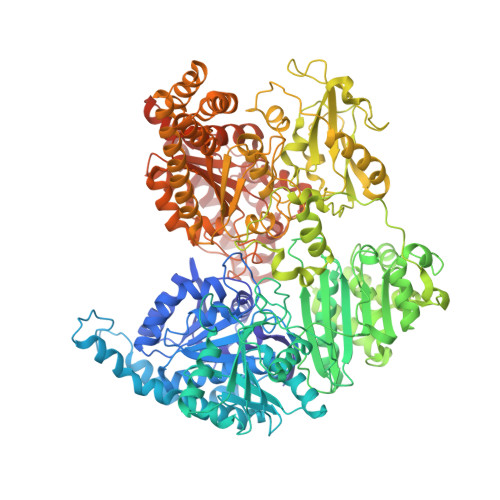Binding site for coenzyme A revealed in the structure of pyruvate:ferredoxin oxidoreductase fromMoorella thermoacetica.
Chen, P.Y., Aman, H., Can, M., Ragsdale, S.W., Drennan, C.L.(2018) Proc Natl Acad Sci U S A 115: 3846-3851
- PubMed: 29581263
- DOI: https://doi.org/10.1073/pnas.1722329115
- Primary Citation of Related Structures:
6CIN, 6CIO, 6CIP, 6CIQ - PubMed Abstract:
Pyruvate:ferredoxin oxidoreductase (PFOR) is a microbial enzyme that uses thiamine pyrophosphate (TPP), three [4Fe-4S] clusters, and coenzyme A (CoA) in the reversible oxidation of pyruvate to generate acetyl-CoA and carbon dioxide. The two electrons that are generated as a result of pyruvate decarboxylation are used in the reduction of low potential ferredoxins, which provide reducing equivalents for central metabolism, including the Wood-Ljungdahl pathway. PFOR is a member of the 2-oxoacid:ferredoxin oxidoreductase (OFOR) superfamily, which plays major roles in both microbial redox reactions and carbon dioxide fixation. Here, we present a set of crystallographic snapshots of the best-studied member of this superfamily, the PFOR from Moorella thermoacetica ( Mt PFOR). These snapshots include the native structure, those of lactyl-TPP and acetyl-TPP reaction intermediates, and the first of an OFOR with CoA bound. These structural data reveal the binding site of CoA as domain III, the function of which in OFORs was previously unknown, and establish sequence motifs for CoA binding in the OFOR superfamily. Mt PFOR structures further show that domain III undergoes a conformational change upon CoA binding that seals off the active site and positions the thiolate of CoA directly adjacent to the TPP cofactor. These structural findings provide a molecular basis for the experimental observation that CoA binding accelerates catalysis by 10 5 -fold.
Organizational Affiliation:
Department of Chemistry, Massachusetts Institute of Technology, Cambridge, MA 02139.


















